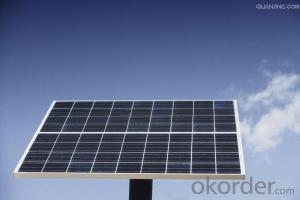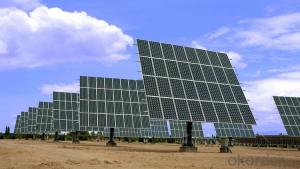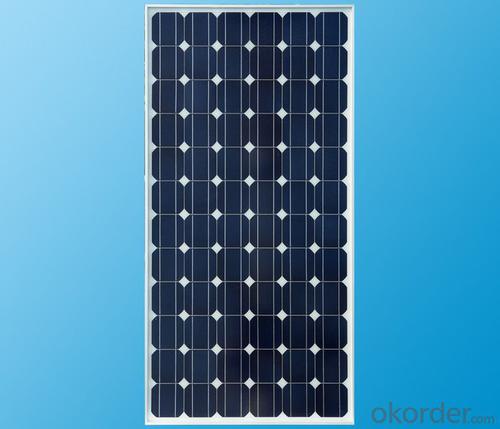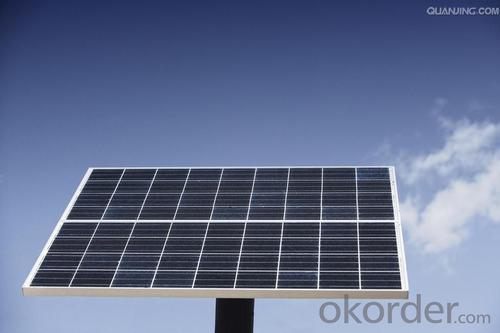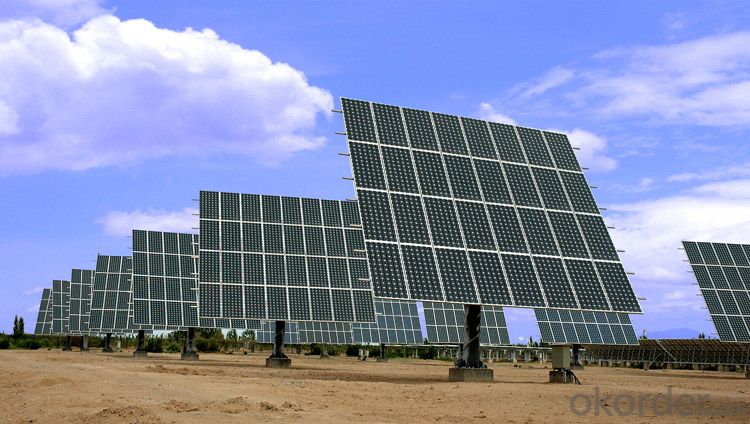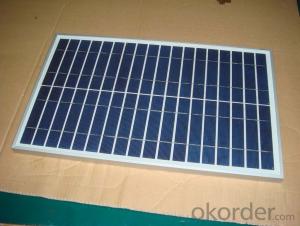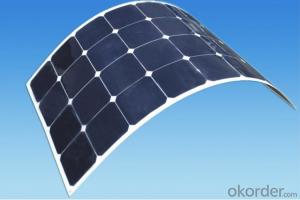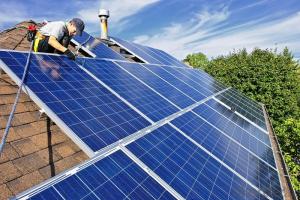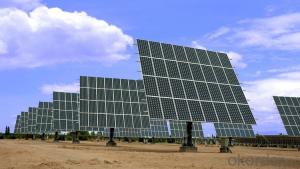Amorphous Silicon Solar Cells - Favorites Compare Best Price Power 100W 18V Solar Panel in Solar System
- Loading Port:
- China Main Port
- Payment Terms:
- TT OR LC
- Min Order Qty:
- -
- Supply Capability:
- 10000000000000 watt/month
OKorder Service Pledge
OKorder Financial Service
You Might Also Like
Quick Details
| Place of Origin: | Guangdong China (Mainland) | Brand Name: | CAP | Model Number: | 50w100w150w200w250w300w |
| Material: | Monocrystalline Silicon | Size: | 1385*1035*75mm | Number of Cells: | 72pcs |
| Max. Power: | 300w | type: | solar panel | color: | blue&black |
| warranty: | 5 years |
Packaging & Delivery
| Packaging Detail: | standard export package for solar panel |
| Delivery Detail: | 7-15 days for solar panel |
Specifications
solar panel
High Efficiency
25 years Warranty
High-transmissivity low-iron tempered glass
Solar Panel
50w100w150w200w250w300w
Characteristics
1,High and stable conversion efficienly based on over 4 years professional experience
2 ,High reliability with guaranteed +/-10% output power tolerance
3,Proven materials,tempered front glass,and a sturdy anodized aluminum frame allow modules to operate reliably in multiple mountily configurations
4,Combination of high efficicncy and attractive appearance
Quality and Safety
1,25 year 80%,10 year 90% power warranty 3 year power warranty
2,ISO9001:2000 (Quality Management system) certified factory
3,Product Quality warranty & products Liability Insurance to guarantee and user' benefits
4,Certifications TUV Intercert, CE Temperature Coefficients
| Module Type | 100w | 150w | 200w | 250w | 300w |
| Maximum Power at ST(Pmax)W | 100wp | 150wp | 200wp | 250wp | 300wp |
| Maximum Power Voltage(Vmp)V | 36/18 | 36/18 | 36/18 | 30.8v | 36/18 |
| Maximum Power Current(Imp)A | 2.77/5.55 | 4.16/8.33 | 5.55/11.1 | 8.11A | 8.33/16.66 |
| Open Circuit Voltage(Voc)V | 39.5/19.05 | 39.3/19.4 | 39.6/19.5 | 36.2V | 39.6/19.8 |
| Short Circuit Current(Isc)A | 3.04/6.09 | 4.58/9.16 | 6.1/12.2 | 8.7A | 9.16/18.33 |
| Cell Efficiency(%) | 18.60% | 18.10% | 18.60% | 17.80% | 18.10% |
| Module Efficiency(%) | 17.70% | 17.20% | 17.70% | 17.10% | 17.20% |
| Operating Temperature°C | -40°C to +85°C | -40°C to +85°C | -40°C to +85°C | -40°C to +85°C | -40°C to +85°C |
| Maximum system voltage | 1000V(IEC)DC | 1000V(IEC)DC | 1000V(IEC)DC | 1000V(IEC)DC | 1000V(IEC)DC |
| Power tolerance | -0.03 | -0.03 | -0.03 | -0.03 | -0.03 |
| Temperature coefficients of Pmax | -0.45%/°C | -0.45%/°C | -0.45%/°C | -0.45%/°C | -0.45%/°C |
| Temperature coefficients of Voc | -0.27%/°C | -0.27%/°C | -0.27%/°C | -0.27%/°C | -0.27%/°C |
| Temperature coefficients of Isc | 0.05%/°C | 0.05%/°C | 0.05%/°C | 0.05%/°C | 0.05%/°C |
| Weight(kg) | 8 | 11 | 14 | 20 | 25.5 |
| Number of cell(pcs) | 4*9 | 4*9 | 6*10 | 6*12 | 6*12 |
| Dimensions(mm) | 1194*534*35/30 | 1580*808*50/35 | 1471*670*40/35 | 1640*992*50 | 2000*1050*50 |
- Q: What are the tin bands, sinks and interconnections used on solar modules, and what are the solar cells used in the solar cells?
- Light incident on the side of the general agreement for the positive, ordinary p-type battery front pn knot is the final need to use, and the back is called back knot.
- Q: What are the advantages of using solar cells?
- The advantages of using solar cells include renewable and sustainable energy generation, reduced greenhouse gas emissions, lower energy costs in the long run, and increased energy independence. Solar cells also require minimal maintenance and have a long lifespan, making them a reliable and durable energy solution.
- Q: How much energy can a solar cell generate?
- A solar cell can generate varying amounts of energy depending on factors such as its size, efficiency, and the amount of sunlight it receives. On average, a standard solar cell can produce around 200 to 400 watts of power per square meter under ideal conditions. However, advancements in technology continue to increase the efficiency and output of solar cells, allowing for even greater energy generation in the future.
- Q: How do solar cells perform in areas with high levels of dust?
- Solar cells tend to perform less efficiently in areas with high levels of dust. The dust particles can accumulate on the surface of the solar panels, reducing their ability to absorb sunlight and convert it into electricity. This buildup can lead to a decrease in energy production and overall performance of the solar cells. Regular cleaning and maintenance of the panels are necessary to mitigate the impact of dust and ensure optimal efficiency.
- Q: Can solar cells be used to power street lights?
- Yes, solar cells can be used to power street lights. Solar-powered street lights utilize photovoltaic panels to convert sunlight into electricity, which is then stored in batteries. This stored energy is used to power the street lights during the night, providing an eco-friendly and cost-effective lighting solution for public spaces.
- Q: Can solar cells be used in underwater applications?
- Yes, solar cells can be used in underwater applications. However, special considerations need to be taken into account, such as protecting the cells from water damage and optimizing their performance in low light conditions. Waterproof enclosures and specialized coatings can help ensure the durability and efficiency of solar cells in underwater environments.
- Q: Can solar cells be used to power electric fences?
- Yes, solar cells can be used to power electric fences. Solar panels can convert sunlight into electricity and store it in batteries, which can then be used to power the electric fence. This allows for a sustainable and reliable power source for electric fences, especially in remote locations where connecting to the grid may not be feasible.
- Q: What is the environmental impact of solar cell production?
- The environmental impact of solar cell production is relatively low compared to other forms of energy production. The manufacturing process of solar cells does generate some greenhouse gas emissions and other pollutants, but these emissions are significantly lower compared to traditional fossil fuel-based energy sources. Additionally, the use of solar energy helps reduce carbon dioxide emissions and dependence on fossil fuels, thereby mitigating climate change and promoting a cleaner and more sustainable future.
- Q: What is the future of solar cells?
- The future of solar cells is promising and bright. With advancements in technology and increasing efficiency, solar cells are becoming more affordable and accessible. The integration of solar power into everyday objects and the development of flexible and transparent solar cells are opening up new possibilities for renewable energy generation. Additionally, research is underway to improve the storage and conversion of solar energy, further enhancing the efficiency and effectiveness of solar cells. As the world continues to prioritize clean energy solutions, the future of solar cells looks to be a key component in achieving a sustainable and greener future.
- Q: How are solar cells tested for quality?
- Solar cells are tested for quality through a series of rigorous assessments and measurements. These tests typically include evaluating the electrical performance, efficiency, durability, and reliability of the solar cells. Various industry standards and protocols are followed to ensure accurate and consistent testing. This involves measuring parameters like open-circuit voltage, short-circuit current, fill factor, and power output under standard test conditions. Additionally, solar cells undergo tests for mechanical strength, resistance to environmental factors (such as temperature, humidity, and UV radiation), and long-term stability to ensure their quality and performance over their lifespan.
Send your message to us
Amorphous Silicon Solar Cells - Favorites Compare Best Price Power 100W 18V Solar Panel in Solar System
- Loading Port:
- China Main Port
- Payment Terms:
- TT OR LC
- Min Order Qty:
- -
- Supply Capability:
- 10000000000000 watt/month
OKorder Service Pledge
OKorder Financial Service
Similar products
Hot products
Hot Searches
Related keywords

